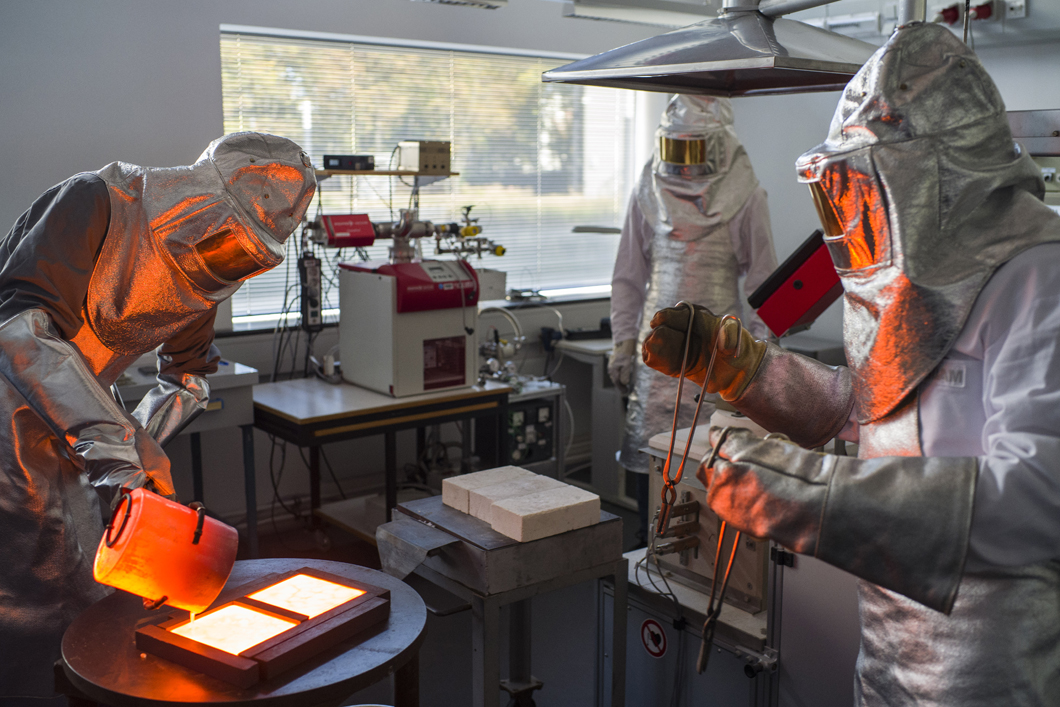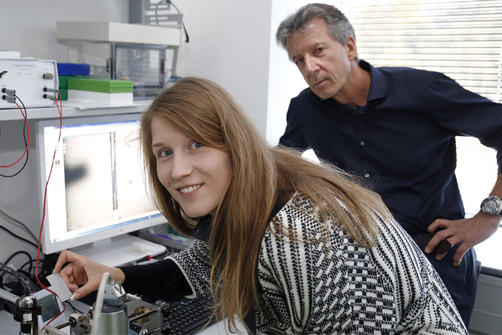
BAM scientists casting glass blocks
Source: Adlershof Journal
By Rico Bigelmann from the Adlershof Journal November/December issue 2018
When Ralf Müller talks about glass, he easily goes into raptures. “A fascinating material, distinctly lighter than steel and also firmer,” says the manager of the Glass division at BAM in Berlin Adlershof – to which he added: “In theory!” Müller and his colleagues are researching how to approach this theoretical strength. As part of the Priority Programme of the German Research Society (DFG), the BAM, together with the Clausthal University of Technology and Leibniz University Hannover, is investigating how glass could become more shatter resistant.
The Egyptians and Mesopotamians invented the glass production between 3,000 and 4,000 years ago. But even Stone Age people had used natural glass as knives and shavers. It was a long way to the first automatic bottle blowing machine in 1903. Today, glass as a material has more versatile uses than ever, far beyond that of window-, drinking- and preserving jar glass. Glass tubes are utilised as bioreactors for algae cultivation; glass fibre reinforced polymers open up new possibilities for shipbuilding or for the construction of large wind turbines; smartwatches are fitted with a special scratch resistant glass, and special glass protects the Juno space probe camera, which has been transmitting images of Jupiter since 2006. Display glass for electrical devices, mobile phones, televisions and computers, as a building material, solder glass, or even as an implant, glass has become indispensable. “We wouldn’t manage without glass”, says Ralf Müller. “It is extremely versatile, can withstand high temperatures, is dimensionally stable and can be shaped in many ways, absolutely air-tight as a packaging material, tasteless, without interdependencies to other materials, and also easily recycled.” But: it breaks.
Even though glass can achieve a very high stability, this stability can barely be used, mainly due to its weak resistance to surface damage. Water has a decisive influence on how dangerous these damages are. For example, even microscopically small cracks and their growth is heavily influenced by air humidity or the water trapped during the manufacture process. The research into the effect of water on crack growth brings experts in the fields of strength, glass structure, solution and diffusion of water in glass together for one DFG project. The objective of which is to derive structural design principles for the development of ultra strong glass.
“We are investigating the crack growth in glasses and what influence water and glass composition has on this.” explained Tina Waurischk, a PhD student at BAM. For this purpose, she has built a device in which slowly growing cracks can be examined in different environments and also in a vacuum. Waurischk clamps glass samples into the device and subjects them to tensile stress.

Tina Waurischk and Dr Ralf Müller from the Glass division research what influence water and glass composition has on crack propagation.
Source: Adlershof Journal
“We know practically nothing about the general effect glass composition has on crack growth,” explains Ralf Müller. The fact that cracks in glasses spread faster at high humidity is not new, however, previous research has almost exclusively considered technical glass. “Even though we are conducting basic research here, we still bear everyday glass products in mind.” said Müller. Although there are already processes to reinforce glass, these are either not practical or too expensive for everyday products. Lighter, but also equally sturdy drinking bottles for example, save not only material; they simplify transport for products and their customers due to their lower weight, reduce energy consumption and thus protect the environment. With ultra-strong, crack free glass, for example, huge shatter-resistant glass constructions for photovoltaics is imaginable. “Theoretically, a millimetre of glass fibre can hold a ton of steel,” smiles Müller, “but the battle against nature is tough.”


